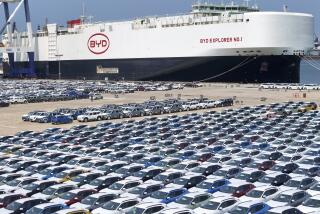Strict Rules Put Brakes on Singapore Smog
- Share via
SINGAPORE — In other big Asian cities, growing wealth has unleashed a flood of cars, trucks and buses that foul the air with exhaust and snarl the streets with traffic jams that can stretch for miles.
But even as Singapore has matched their growth, it has escaped the curse of traffic congestion. Its air is clean. A cab ride to the airport from downtown takes 15 minutes.
This happy situation is no accident. It is the work of a traffic-control program that fights smog and traffic by making this Southeast Asian island nation one of the costliest places in the world to drive.
At the heart of the system lies an unusual tool that has become a badge of middle-class success: a permit to own a car.
Sold at monthly auctions in limited numbers, the 10-year licenses command prices of up to $75,000. Add sales tax and import duty totaling 195% of a car’s value, and a buyer can spend the equivalent of $200,000 before hitting Singapore’s tidy, pothole-free streets.
On top of that, Singapore charges drivers to enter downtown on weekdays and is getting ready to impose tolls on all major roads. Heavily taxed gasoline is kept expensive to discourage driving.
Other Asian governments are studying the program, and a few have plans to try using tolls to reduce traffic on key roads.
But Singapore’s approach can’t be easily reproduced. The governing party has been firmly in power since 1965 and is so sure of its control that it can ignore resistance that might make other governments back down.
It helps, too, that a car isn’t a necessity in a country so small that a bicyclist can pedal from one end to the other before lunch. Buses and taxis are plentiful. A mass-transit railway covers much of the 25-mile-long island.
*
The system has spared Singapore the traffic ordeals of cities like Bangkok, the Thai capital whose noxious air was blamed in the 1995 death of a policeman who collapsed on the job. Or Jakarta, Indonesia, where police carry oxygen bottles for bad-air days.
“If that’s the price we have to pay to keep from becoming like Bangkok, then, well, I guess we have to pay it,” said Tan Puay Chin, a computer company employee who shares a Toyota sedan with her brother.
The Tans paid $53,000 for their Corolla and its permit in 1992. They already are shopping for a replacement because prices are rising so fast that the same model with permit now costs $100,000.
“If we wait any longer, we won’t be able to afford a car at all,” Tan said.
*
That would suit Singapore’s leaders, who have kept this nation of 3 million people clean and green while presiding over its rise as a port and center for banking and electronics manufacturing.
The government created the permits in 1991 in an attempt to slow the growth of car ownership.
Despite the cost, there is no shortage of bidders for the 3,000 to 3,500 permits issued each month. Most are sold to car dealers, who sell them with new cars and pass on the cost to buyers, sparing them the effort of acquiring their own permits.
The result is there are 350,000 cars on Singapore, or one for every eight people. The government says it will let that rise to 540,000 cars by 2010.
Economists blame the free spending on cars for a steep slump afflicting the Singapore retail industry. They say consumers have so much money tied up in cars that they have little left to spend on anything else.
Cost has made the permit system such a sensitive issue that few will discuss it publicly. Officials who control the permits, the industry group of car dealers and the Singapore Automobile Assn. all declined requests for interviews.
The permits and their fluctuating prices, which are reported by TV news and fuel cocktail party chatter, are just the start of the system.
Police use closed-circuit television to coordinate stoplights and manage traffic flows. Stores, churches and other owners of public parking spaces are taxed for each space to discourage them from offering free parking.
Heavily taxed gasoline costs the equivalent of $4.46 a gallon, compared to $1.69 in neighboring Malaysia. To prevent drivers from heading across the causeway just to fill up, cars are barred from leaving Singapore with fuel tanks less than half full.
To fight inner-city congestion, drivers are charged $1.40 to enter downtown on weekdays. Plans call for tolls on every major road by the end of 1997, using electronic sensors to bill passing cars automatically.
But if Singapore has any lesson to teach, it is that high cost alone cannot cool the public’s love affair with the automobile. It may even fuel the snob appeal of the Rolls-Royces, Mercedes-Benzes and other luxury models that fill Singapore’s streets.
Mercedes has been the top seller for three years, with more than 4,000 cars sold in 1996. One dealership has 21 orders for the new Porsche Boxster sports car priced at $235,000.
With incomes rising rapidly, no one is forecasting an end to demand by Singaporeans for cars and their expensive permits.
“Most people who have had a car, or just feel peer pressure, still want a car,” said Chye Kit Soon, a lawyer who writes for Drive, a Singapore car magazine.
More to Read
Sign up for Essential California
The most important California stories and recommendations in your inbox every morning.
You may occasionally receive promotional content from the Los Angeles Times.










